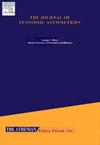Evaluating the symmetry of trade policy: Evidence from liberalization reversals
Q1 Economics, Econometrics and Finance
引用次数: 0
Abstract
Is trade policy symmetric? Using a dataset of trade agreements from 1986 to 2016, we identify 596 instances of trade liberalization reversals where standing agreements are revoked and barriers to trade are reinstated. We study the impact of these reversals on import volumes to understand whether the size of trade flows responses to liberalization and protectionist policies are symmetric. The baseline results do not reject the null hypothesis of perfect policy symmetry: after a liberalization policy is reversed trade flows are on average indistinguishable from flows that did not experience earlier liberalization. Heterogeneity analysis reveals, however, that attributes of reversed policies, such as length and depth, impact their symmetry properties. In a context of increased policy volatility and evolving trade policymaking framework, this study pioneers research about the relative impacts and the persistence of liberalization and protectionism. The findings equip policymakers with critical insights into the durable benefits of liberalization, amidst protectionist pressures, and open new avenues for future research to explore the intricate dynamics of trade policy symmetry.
评估贸易政策的对称性:来自自由化逆转的证据
贸易政策是否对称?使用1986年至2016年的贸易协定数据集,我们确定了596个贸易自由化逆转的实例,其中现有协议被撤销,贸易壁垒被恢复。我们研究了这些逆转对进口量的影响,以了解贸易流量的规模对自由化和保护主义政策的反应是否对称。基线结果并没有拒绝完美政策对称的零假设:在自由化政策逆转后,贸易流量与没有经历早期自由化的流量平均无法区分。然而,异质性分析表明,反向政策的属性,如长度和深度,会影响它们的对称性。在政策波动加剧和贸易政策制定框架不断演变的背景下,本研究率先研究了自由化和保护主义的相对影响和持久性。这些发现为政策制定者提供了在保护主义压力下自由化的持久利益的关键见解,并为未来研究探索贸易政策对称的复杂动态开辟了新的途径。
本文章由计算机程序翻译,如有差异,请以英文原文为准。
求助全文
约1分钟内获得全文
求助全文
来源期刊

Journal of Economic Asymmetries
Economics, Econometrics and Finance-Economics, Econometrics and Finance (all)
CiteScore
4.80
自引率
0.00%
发文量
42
审稿时长
50 days
 求助内容:
求助内容: 应助结果提醒方式:
应助结果提醒方式:


